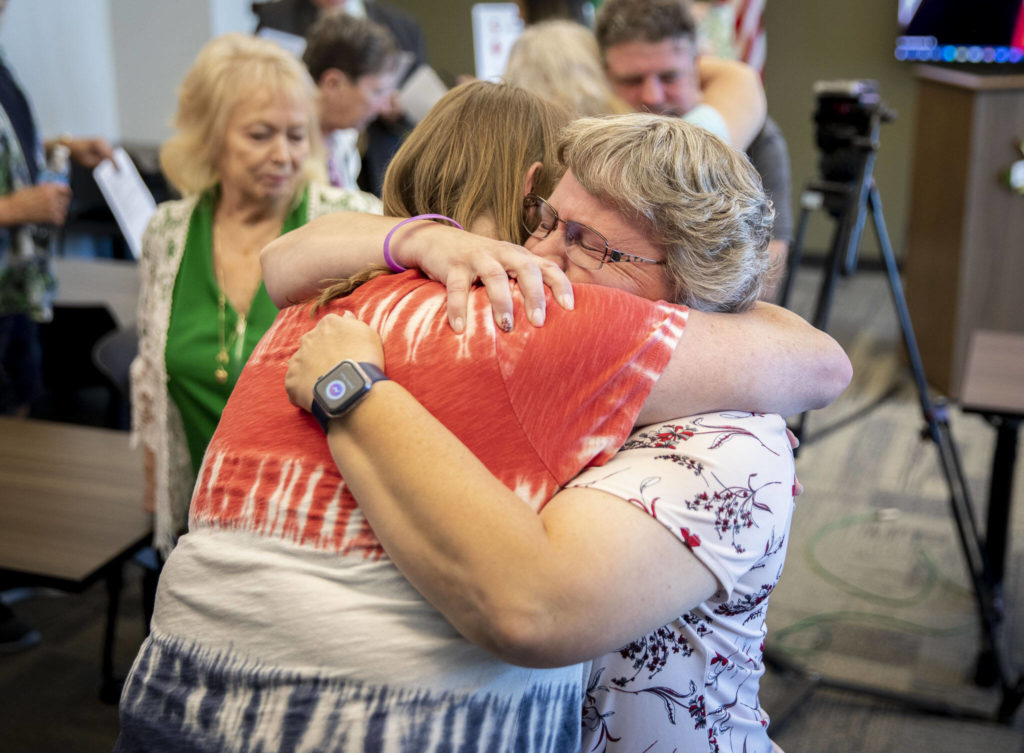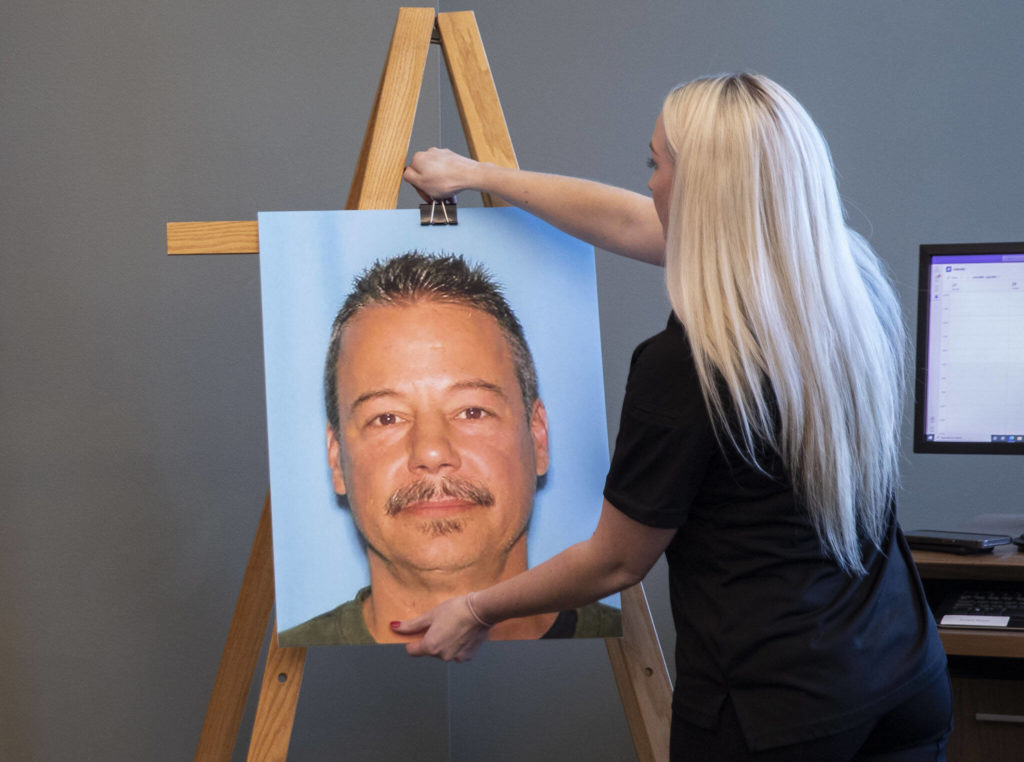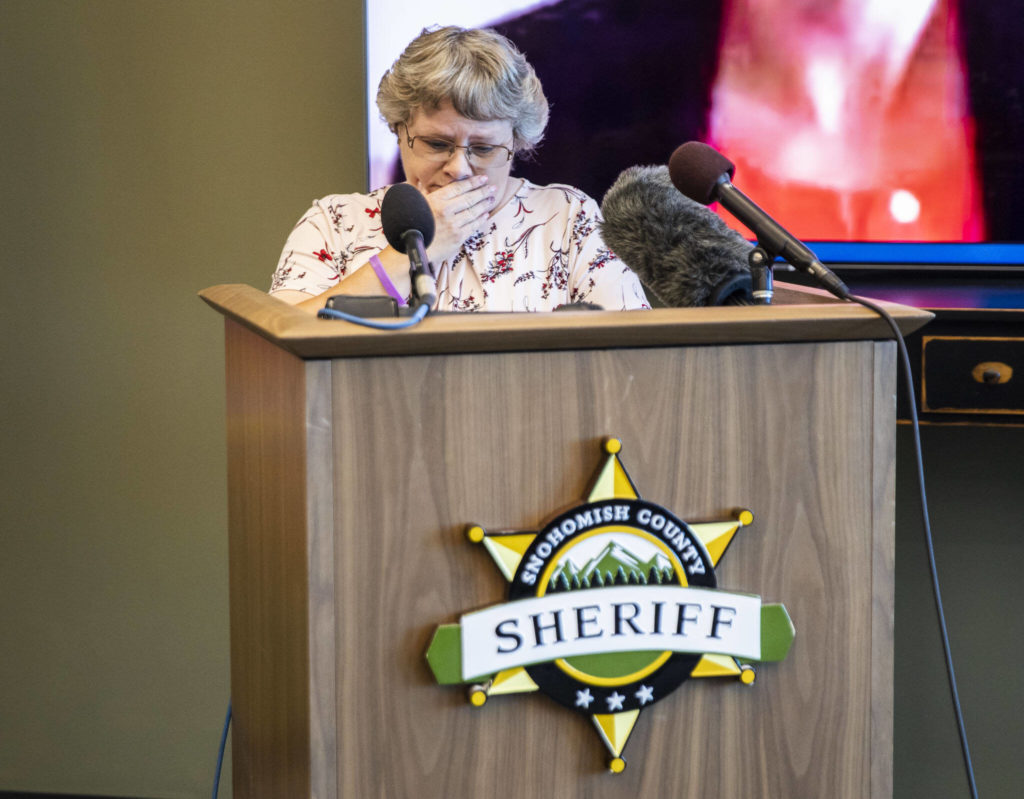EVERETT — Melissa Johnson misses games of Gin Rummy with her best friend, hanging on to the four of hearts as a tease because it was Michelle Koski’s favorite card.
She misses waiting hours for Koski to wake up — and then a few more hours for her friend to get ready.
“I miss her getting mad at me for calling her ‘Mitch,’” said Johnson, her head barely poking over a podium Thursday at the Snohomish County Sheriff’s Office.
The same month she was killed, Koski turned 17. It took 31¾ years to find a suspect.
A woman walking her dog on a wooded stretch near Highway 522 and Echo Lake Road discovered the body Aug. 25, 1990, a few miles north of the King County line. She had been sexually assaulted, strangled and beaten.
Her alleged killer was identified Thursday through forensic genealogy, a technique where DNA from an unsolved case is uploaded to public ancestry databases in search of relatives. Once both sides of an unidentified person’s family tree have been mapped, police can zero in on a suspect.
Robert Anthony Brooks served prison time for juvenile offenses. He was released April 18, 1990, four months before the slaying. In the early 1990s, Brooks lived with a relative a few blocks southwest of Koski’s home in Lake City. At the time of the killing, he was 23. He died Oct. 26, 2016. During his life, he was never on detectives’ radar in the Koski case.
Koski, a Seattle high school senior, had somehow gotten a ride Aug. 20, 1990, to a spot in south Snohomish County near Maltby “where teenagers were known to hang out, drink and ride motorcycles,” according to a recent report by Dateline NBC. It was near the woods where her body was recovered five days later. Detectives long believed Koski was brought to the space to hang out, party and drink, “but then things took a terrible turn.” However, investigators are still not sure exactly how and when she crossed paths with Brooks.
Friends and family described Koski in news articles as “brilliant,” “super smart” and someone who would make an “awesome lawyer.”
“I only knew her for seven years, but it was a lifetime as a kid,” Johnson said Thursday.
One day in the girl’s bathroom in elementary school, she asked Johnson if she had a best friend.
“No,” Johnson answered. “Do you have one?”
“No. Want to be my best friend?”
So they became best friends.
“I miss her protectiveness for the ones that she loved, but she was also very gentle at the same time,” Johnson said.
Koski grew into a standout softball player: a pitcher, shortstop, occasional slugger and two-time most valuable player for Summit K-12 alternative school, according to a profile in The Seattle Times published a week after her death.
Koski skipped eighth grade. After cutting classes in high school, Koski aimed to graduate on time and attend college the next fall for a law degree. In the meantime, she worked at Taco Bell.
An August 1990 headline in The Times read: “Not A Street Kid, Not A Hard Kid,” pushing back on a portrayal of Koski in police reports that suggested she was without a fixed address and spent her time hanging out on “The Ave” in the University District.
She had been living with a 28-year-old boyfriend in Lake City, though she told her mother and best friend she planned to move out, according to media reports. Detectives quickly identified the boyfriend as a person of interest. He was later ruled out as a suspect, as were others.
Koski made at least four phone calls on the night of Aug. 20, investigators told media at the time. One was to her mother. Koski agreed to move back into her family’s house and take care of the dog, while her mother and stepfather went on a trip. According to her mother, Violet Simonson, the daughter told friends she was going home.
“God gave me a very special gift, and I got to keep it safe for 17 years,” the mother said in 1990. “I’m still disjointed. It feels like my baby girl is just away at school.”
Simonson spoke at a memorial of about 200 people.
“She would pick up stray dogs and stray cats and stray people and bring them home all the time,” she told the crowd in 1990.
Simonson’s worst fear, wrote Times reporter Jolayne Houtz, was that “the person who attacked her daughter won’t be caught.”
“She would never hurt a fly, and yet someone thought they had the right to hurt her,” the mother told the newspaper.
Another story’s headline from Sept. 1, 1990: “Police Narrowing Suspects In 17-Year-Old’s Murder.”
Around the time Koski’s body was found, the Green River killer had been terrorizing the Seattle area for about a decade. As a matter of routine, Seattle investigators considered a serial killer to be a possibility, The Times reported.
Brooks was never suspected in another homicide, Snohomish County sheriff’s detective Jim Scharf said Thursday. His DNA had never been uploaded into the national database CODIS.
Eighteen years after her daughter’s death, Simonson told The Daily Herald she wanted “to see the killer caught out of fairness for Michelle,” but that she didn’t believe in vengeance or the death penalty.
“She leaves judgment up to God,” reporter Diana Hefley wrote.
“I don’t know why my daughter had to die and I lived,” Simonson told The Herald. “That’s not up to me.”
In 2008, the Snohomish County sheriff’s cold case team released a deck of playing cards featuring faces of victims, handing them out to prisoners and others in hope of finding leads. Koski was the five of diamonds. The card gives her whereabouts in her last week alive: An apartment in Ballard on the morning of Aug. 18, 1990, then dropped off by a friend that day at her shared apartment in Lake City.
Investigators were reviewing evidence for possible genetic testing in 2008, Snohomish County sheriff’s detective Dave Heitzman said.
In the end, it was DNA that led to a breakthrough.
Parabon NanoLabs conducted genetic analysis using swabs taken from Koski’s body. The same lab helped crack the 1987 homicides of young Canadian couple Jay Cook and Tanya Van Cuylenborg, a landmark case prosecuted in Snohomish County in 2019. The couple’s case became the first in the country where a jury convicted a suspect who was identified through forensic genealogy — a conviction that has since been overturned and appealed to the state Supreme Court on an unrelated legal question.
In the Koski case, the DNA sample was a mix between the victim and the suspected killer. According to the sheriff’s office, the lab was able to “deconvolute the mixture and ensure that matches would lead to the perpatrator.”
Distant cousins had uploaded their DNA to a public ancestry database — but they were very distant relatives.
Oregon genealogist Deb Stone spent about nine months building family trees, while juggling other complex cases, she said Thursday. She narrowed it down to two brothers, both deceased. Brooks had moved to Arizona and spent years of his life without getting into any serious trouble with the law, then returned to King County. The sheriff’s office secured blood samples from when he died. His body passed through the King County Medical Examiner’s Office. Testing showed an apparent match to DNA in Koski’s homicide.
The sheriff’s office publicly announced Brooks’ identity Thursday at a press conference.
“I know there are very many people who miss her just as much as I do,” Johnson said. “I often wonder where she would have been in life had she still been alive, and how different my life would have been as well.”
Johnson said she had been “praying for this day for a very long time.”
“After almost 32 years, it’s finally come true,” she said.
The slain girl’s mother told TV news crews she was grateful there would be no trial. She said other families waiting for answers should take this case to heart.
“Wait for the technology,” Simonson said. “It’s getting better every day. … Pretty soon, none of those bad guys will be able to hide.”
It’s the third major breakthrough in a cold case the sheriff’s office has announced this month on the fourth floor of the Snohomish County Courthouse.
Alice Williams was publicly identified June 16 as the Beckler River Jane Doe. Her skull was recovered from a steep ravine in October 2009, in the forest north of Skykomish.
Blaine Has Tricks was unidentified for 45 years. His crushed remains were recovered from a landfill near Marysville. Detectives had nicknamed him the Tulalip Landfill John Doe.
All three names were found through forensic genealogy.
The lead detective on these cases, Scharf, was set to retire Thursday. He plans to continue his cold case work as a volunteer.
Detectives still have questions in Koski’s case.
Tips can be directed to the Snohomish County Sheriff’s Office at 425-388-3845.
Caleb Hutton: 425-339-3454; chutton@heraldnet.com; Twitter: @snocaleb.
Talk to us
> Give us your news tips.
> Send us a letter to the editor.
> More Herald contact information.






























